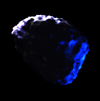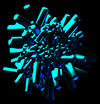(added more info, fixed grammar) |
(added images of the ore chunks) |
||
| Line 3: | Line 3: | ||
The [[asteroid impact of 2184]] with the then-in-construction [[Enceladus Prime]] revealed anomalous mineral concentrations within the [[A Ring]], the primary elements of which are listed below. Note that all ore chunks contain a significant amount of ice, and that their average mass and purity increase as one goes deeper into the rings. | The [[asteroid impact of 2184]] with the then-in-construction [[Enceladus Prime]] revealed anomalous mineral concentrations within the [[A Ring]], the primary elements of which are listed below. Note that all ore chunks contain a significant amount of ice, and that their average mass and purity increase as one goes deeper into the rings. | ||
The graph provides general information on the minerals, including frequency, average chunk masses that you'd expect, the average | The following graph provides general information on the minerals, including frequency, average chunk masses that you'd expect, the average impurities of the ore chunks (how much mineral per total mass), the average cost in metric tonnes, and a visual to reference what each ore chunk looks like: | ||
{| class="wikitable" | {| class="wikitable" | ||
|+ | |+ | ||
| Line 12: | Line 12: | ||
!Average price | !Average price | ||
per metric tonne | per metric tonne | ||
!Chunk | |||
|- | |- | ||
|Iron (Fe) | |Iron (Fe) | ||
| Line 18: | Line 19: | ||
|60% | |60% | ||
|900 E$ | |900 E$ | ||
|[[File:Iron chunk.png|100x100px]] | |||
|- | |- | ||
|Palladium (Pd) | |Palladium (Pd) | ||
| Line 24: | Line 26: | ||
|52% | |52% | ||
|2,500 E$ | |2,500 E$ | ||
|[[File:Palladium chunk.png|100x100px]] | |||
|- | |- | ||
|Platinum (Pt) | |Platinum (Pt) | ||
| Line 30: | Line 33: | ||
|76% | |76% | ||
|2,700 E$ | |2,700 E$ | ||
|[[File:Platinum chunk.png|101x101px]] | |||
|- | |- | ||
|Vanadium (V) | |Vanadium (V) | ||
| Line 36: | Line 40: | ||
|82% | |82% | ||
|3,000 E$ | |3,000 E$ | ||
|[[File:Vanadium chunk.png|100x100px]] | |||
|- | |- | ||
|Tungsten (W) | |Tungsten (W) | ||
| Line 42: | Line 47: | ||
|50% | |50% | ||
|6,500 E$ | |6,500 E$ | ||
|[[File:Tungsten chunk.png|100x100px]] | |||
|- | |- | ||
|Beryllium (Be) | |Beryllium (Be) | ||
| Line 48: | Line 54: | ||
|76% | |76% | ||
|20,500 E$ | |20,500 E$ | ||
|[[File:Beryllium chunk.png|104x104px]] | |||
|} | |} | ||
[[Category:Codex]] | [[Category:Codex]] | ||
Latest revision as of 05:12, 16 September 2024
'Chunks' are the colloquial name for the nuggets of mineral-rich ore that form in the cores of ringroids. They are so common that many spacecraft operating within the rings are exclusively designed with their spherical forms in mind.
The asteroid impact of 2184 with the then-in-construction Enceladus Prime revealed anomalous mineral concentrations within the A Ring, the primary elements of which are listed below. Note that all ore chunks contain a significant amount of ice, and that their average mass and purity increase as one goes deeper into the rings.
The following graph provides general information on the minerals, including frequency, average chunk masses that you'd expect, the average impurities of the ore chunks (how much mineral per total mass), the average cost in metric tonnes, and a visual to reference what each ore chunk looks like:





